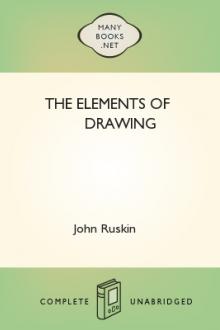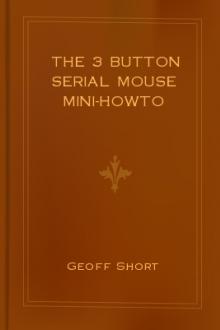The Elements of Drawing by John Ruskin (smart books to read .txt) 📕

xii. One task, however, of some difficulty, the student will find I have not imposed upon him: namely, learning the laws of perspective. It would be worth while to learn them, if he could do so easily; but without a master's help, and in the way perspective is at present explained in treatises, the difficulty is greater than the gain. For perspective is not of the slighte
Read free book «The Elements of Drawing by John Ruskin (smart books to read .txt) 📕» - read online or download for free at americanlibrarybooks.com
- Author: John Ruskin
- Performer: -
Read book online «The Elements of Drawing by John Ruskin (smart books to read .txt) 📕». Author - John Ruskin
105. So in trees in general, and bushes, large or small, you will notice that, though the boughs spring irregularly and at various angles, there is a tendency in all to stoop less and less as they near the top of the tree. This structure, typified in the simplest possible terms at c, Fig. 17, is common to all trees that I know of, and it gives them a certain plumy character, and aspect of unity in the hearts of their branches which are essential to their beauty. The stem does not merely send off a wild branch here and there to take its own way, but all the branches share in one great fountain-like impulse; each has a curve and a path to take, which fills a definite place, and each terminates all its minor branches at its outer extremity, so as to form a greater outer curve, whose character and proportion are peculiar for each species. That is to say, the general type or idea of a tree is not as a, Fig. 17, but as b, in which, observe, the boughs all carry their minor divisions right out to the bounding curve; not but that smaller branches, by thousands, terminate in the heart of the tree, but the idea and main purpose in every branch are to carry all its child branches well out to the air and light, and let each of them, however small, take its part in filling the united flow of the bounding curve, so that the type of each separate bough is again not a, but b, Fig. 18; approximating, that is to say, so far to the structure of a plant of broccoli as to throw the great mass of spray and leafage out to a rounded surface. Therefore beware of getting into a careless habit of drawing boughs with successive sweeps of the pen or brush, one hanging to the other, as in Fig. 19. If you look at the tree-boughs in any painting of Wilson's you will see this structure, and nearly every other that is to be avoided, in their intensest types. You will also notice that Wilson never conceives a tree as a round mass, but flat, as if it had been pressed and dried. Most people in drawing pines seem to fancy, in the same way, that the boughs come out only on two sides of the trunk, instead of all round it: always, therefore, take more pains in trying to draw the boughs of trees that grow towards you than those that go off to the sides; anybody can draw the latter, but the foreshortened ones are not so easy. It will help you in drawing them to observe that in most trees the ramification of each branch, though not of the tree itself, is more or less flattened, and approximates, in its position, to the look of a hand held out to receive something, or shelter something. If you take a looking-glass, and hold your hand before it slightly hollowed, with the palm upwards, and the fingers open, as if you were going to support the base of some great bowl, larger than you could easily hold; and sketch your hand as you see it in the glass with the points of the fingers towards you; it will materially help you in understanding the way trees generally hold out their hands: and if then you will turn yours with its palm downwards, as if you were going to try to hide something, but with the fingers expanded, you will get a good type of the action of the lower boughs in cedars and such other spreading trees.
Fig. 18. Fig. 18. Fig. 19. Fig. 19.106. Fig. 20 will give you a good idea of the simplest way in which these and other such facts can be rapidly expressed; if you copy it carefully, you will be surprised to find how the touches all group together, in expressing the plumy toss of the tree branches, and the springing of the bushes out of the bank, and the undulation of the ground: note the careful drawing of the footsteps made by the climbers of the little mound on the left.[23] It is facsimilëd from an etching of Turner's, and is as good an example as you can have of the use of pure and firm lines; it will also show you how the particular action in foliage, or anything else to which you wish to direct attention, may be intensified by the adjuncts. The tall and upright trees are made to look more tall and upright still, because their line is continued below by the figure of the farmer with his stick; and the rounded bushes on the bank are made to look more rounded because their line is continued in one broad sweep by the black dog and the boy climbing the wall. These figures are placed entirely with this object, as we shall see more fully hereafter when we come to talk about composition; but, if you please, we will not talk about that yet awhile. What I have been telling you about the beautiful lines and action of foliage has nothing to do with composition, but only with fact, and the brief and expressive representation of fact. But there will be no harm in your looking forward, if you like to do so, to the account, in Letter III. of the "Law of Radiation," and reading what is said there about tree growth: indeed it would in some respects have been better to have said it here than there, only it would have broken up the account of the principles of composition somewhat awkwardly.
Fig. 20. Fig. 20.107. Now, although the lines indicative of action are not always quite so manifest in other things as in trees, a little attention will soon enable you to see that there are such lines in everything. In an old house roof, a bad observer and bad draughtsman will only see and draw the spotty irregularity of tiles or slates all over; but a good draughtsman will see all the bends of the under timbers, where they are weakest and the weight is telling on them most, and the tracks of the run of the water in time of rain, where it runs off fastest, and where it lies long and feeds the moss; and he will be careful, however few slates he draws, to mark the way they bend together towards those hollows (which have the future fate of the roof in them), and crowd gradually together at the top of the gable, partly diminishing in perspective, partly, perhaps, diminished on purpose (they are so in most English old houses) by the slate-layer. So in ground, there is always the direction of the run of the water to be noticed, which rounds the earth and cuts it into hollows; and, generally, in any bank or height worth drawing, a trace of bedded or other internal structure besides. Figure 20 will give you some idea of the way in which such facts may be expressed by a few lines. Do you not feel the depression in the ground all down the hill where the footsteps are, and how the people always turn to the left at the top, losing breath a little, and then how the water runs down in that other hollow towards the valley, behind the roots of the trees?
108. Now, I want you in your first sketches from Nature to aim exclusively at understanding and representing these vital facts of form; using the pen—not now the steel, but the quill—firmly and steadily, never scrawling with it, but saying to yourself before you lay on a single touch,—"that leaf is the main one, that bough is the guiding one, and this touch, so long, so broad, means that part of it,"—point or side or knot, as the case may be. Resolve always, as you look at the thing, what you will take, and what miss of it, and never let your hand run away with you, or get into any habit or method of touch. If you want a continuous line, your hand should pass calmly from one end of it to the other without a tremor; if you want a shaking and broken line, your hand should shake, or break off, as easily as a musician's finger shakes or stops on a note: only remember this, that there is no general way of doing any thing; no recipe can be given you for so much as the drawing of a cluster of grass. The grass may be ragged and stiff, or tender and flowing; sunburnt and sheep-bitten, or rank and languid; fresh or dry; lustrous or dull: look at it, and try to draw it as it is, and don't think how somebody "told you to do grass." So a stone may be round or angular, polished or rough, cracked all over like an ill-glazed teacup, or as united and broad as the breast of Hercules. It may be as flaky as a wafer, as powdery as a field puff-ball; it may be knotted like a ship's hawser, or kneaded like hammered iron, or knit like a Damascus saber, or fused like a glass bottle, or crystallized like hoar-frost, or veined like a forest leaf: look at it, and don't try to remember how anybody told you to "do a stone."
109. As soon as you find that your hand obeys you thoroughly, and that you can render any form with a firmness and truth approaching that of Turner's or Dürer's work,[24] you must add a simple but equally careful light and shade to your pen drawing, so as to make each study as complete as possible; for which you must prepare yourself thus. Get, if you have the means, a good impression of one plate of Turner's Liber Studiorum; if possible, one of the subjects named





Comments (0)